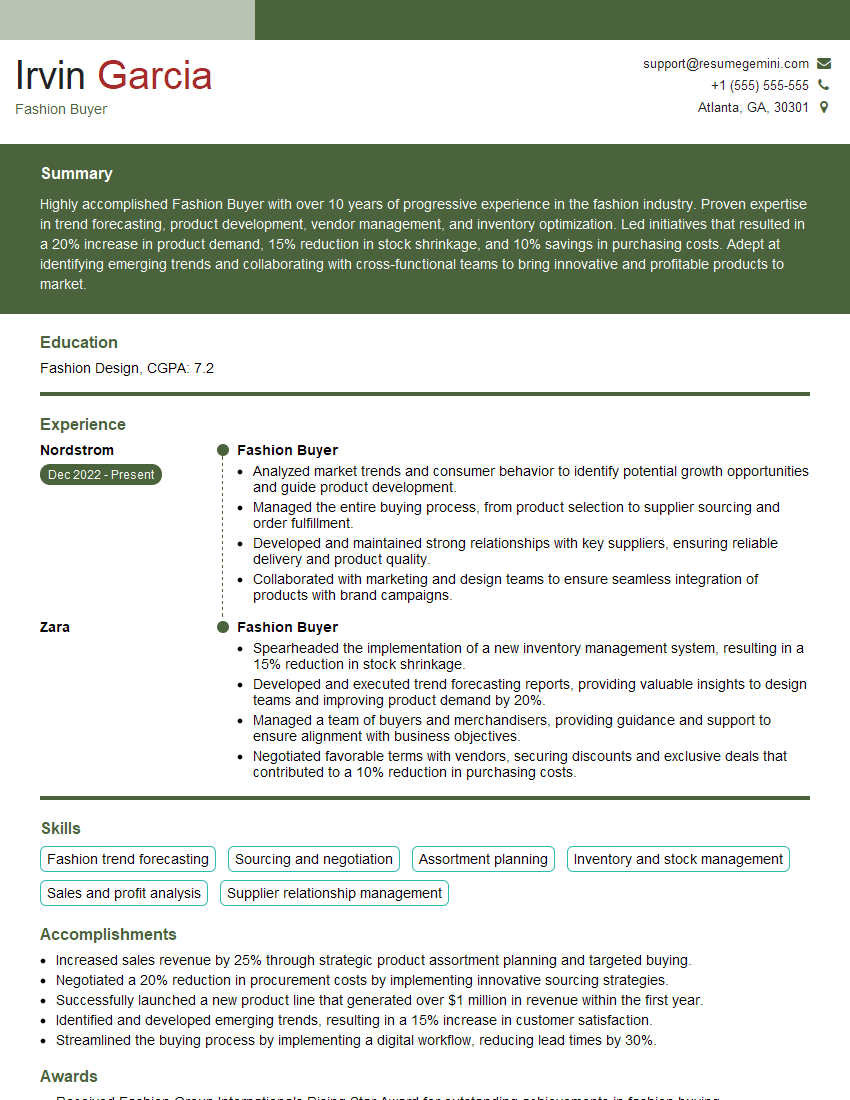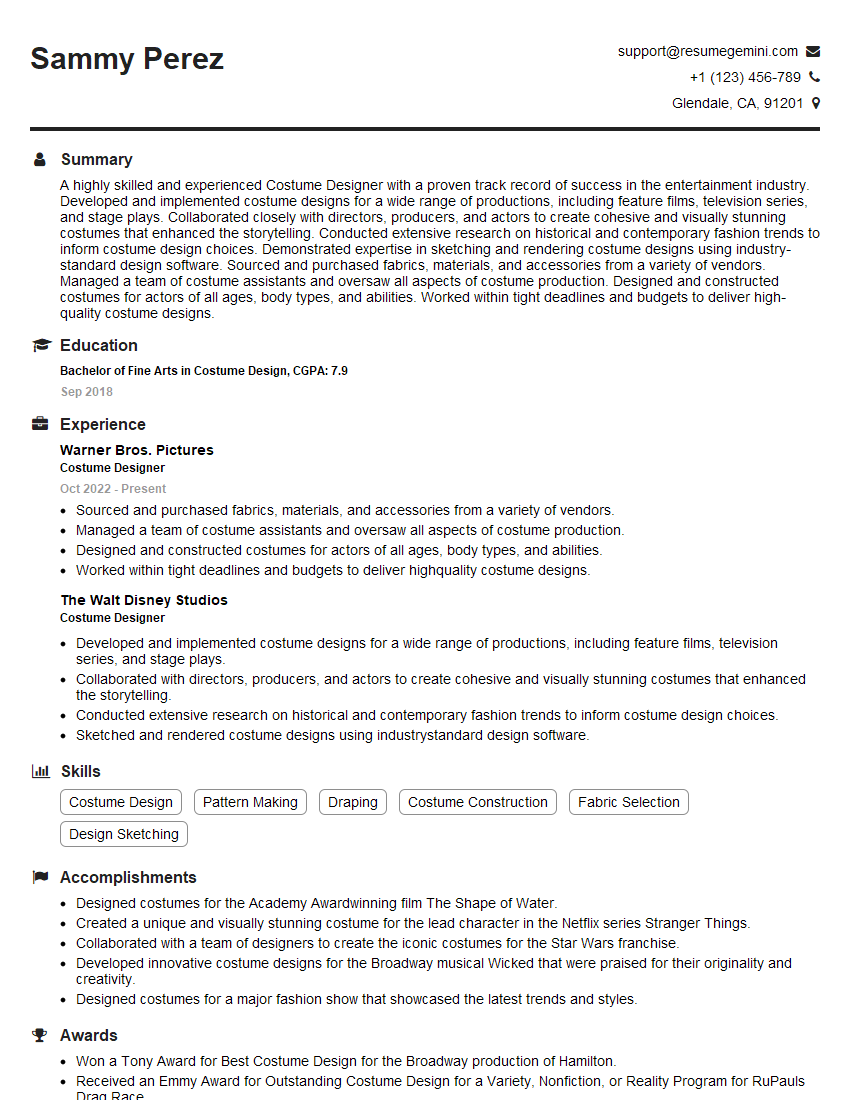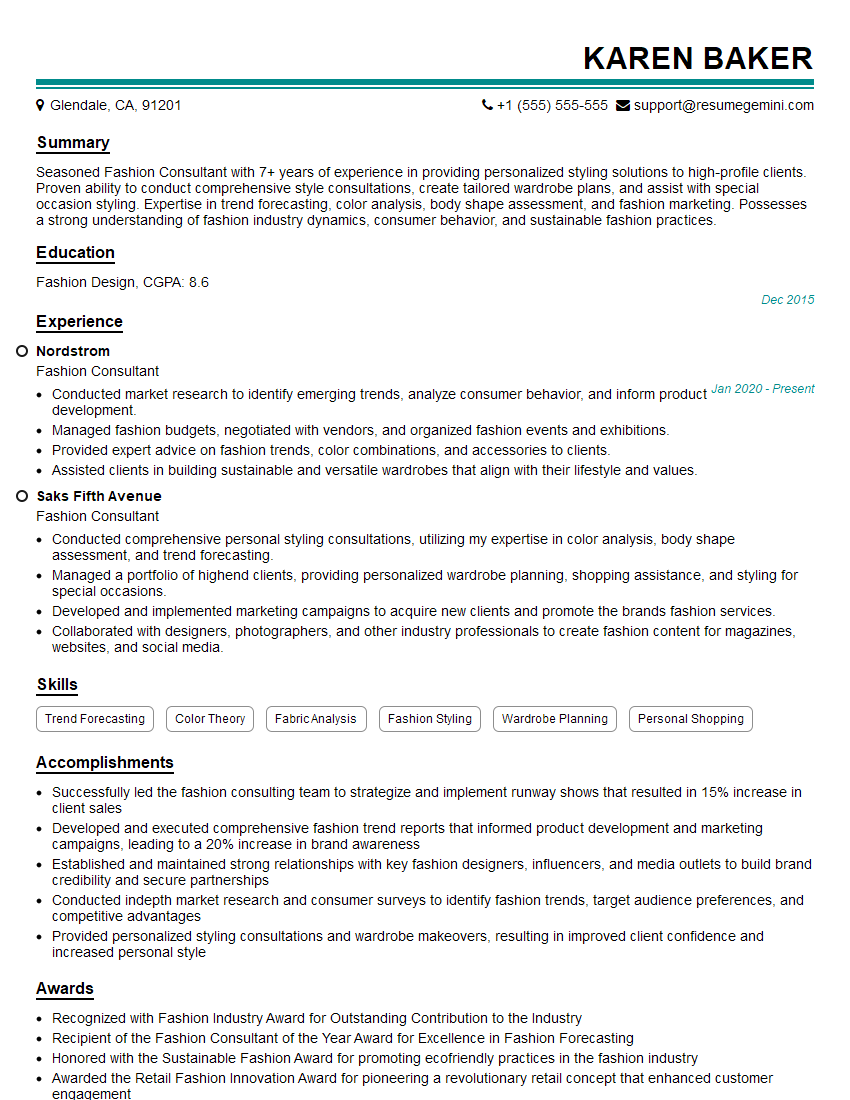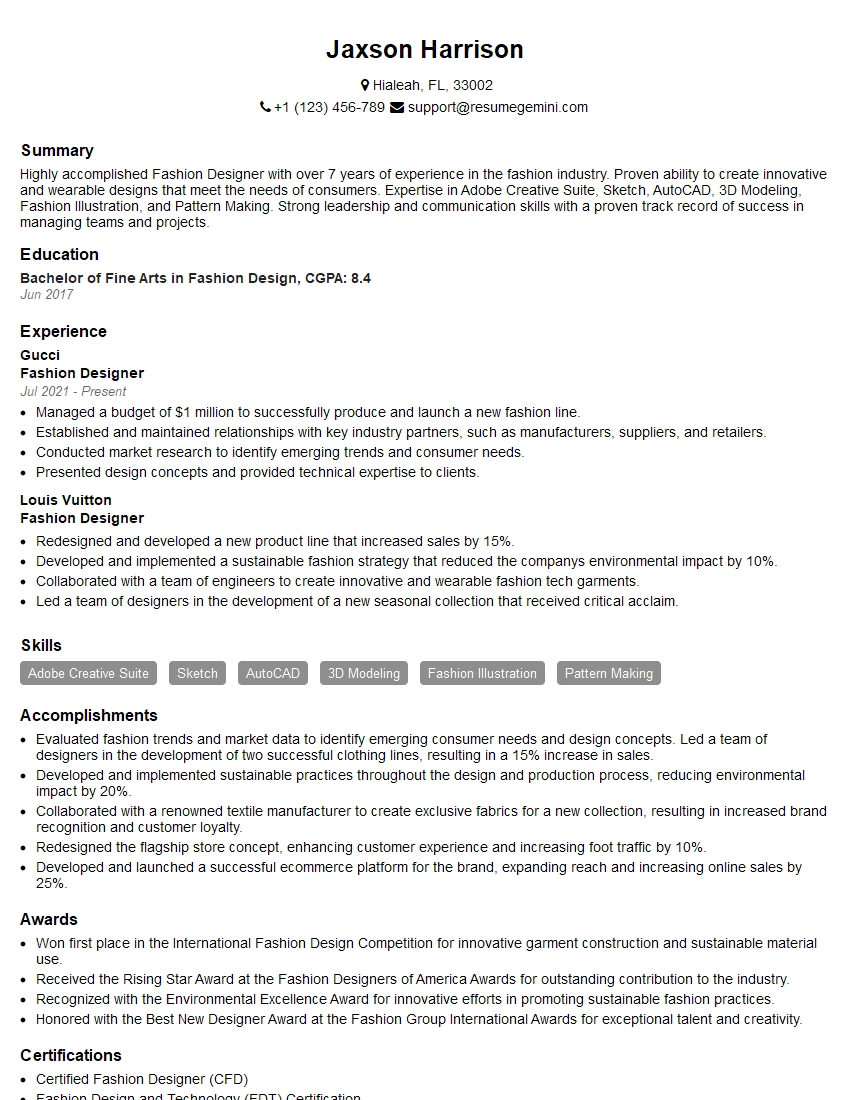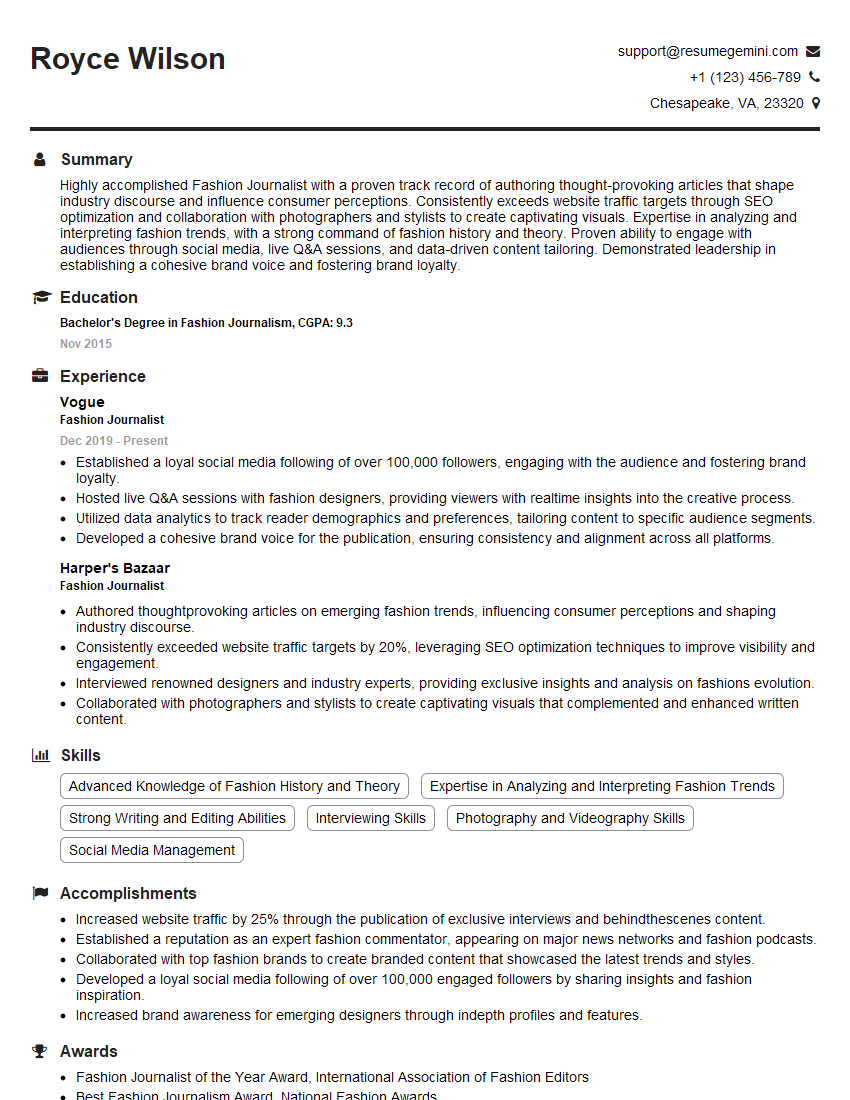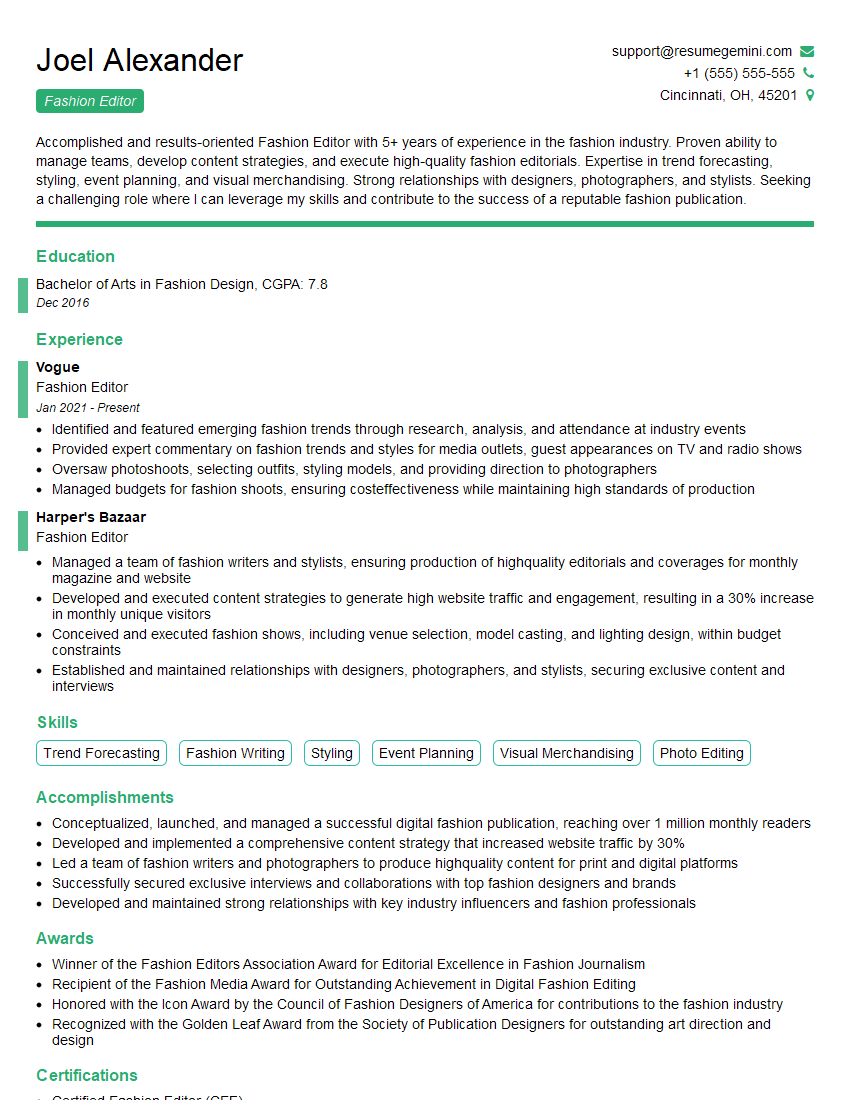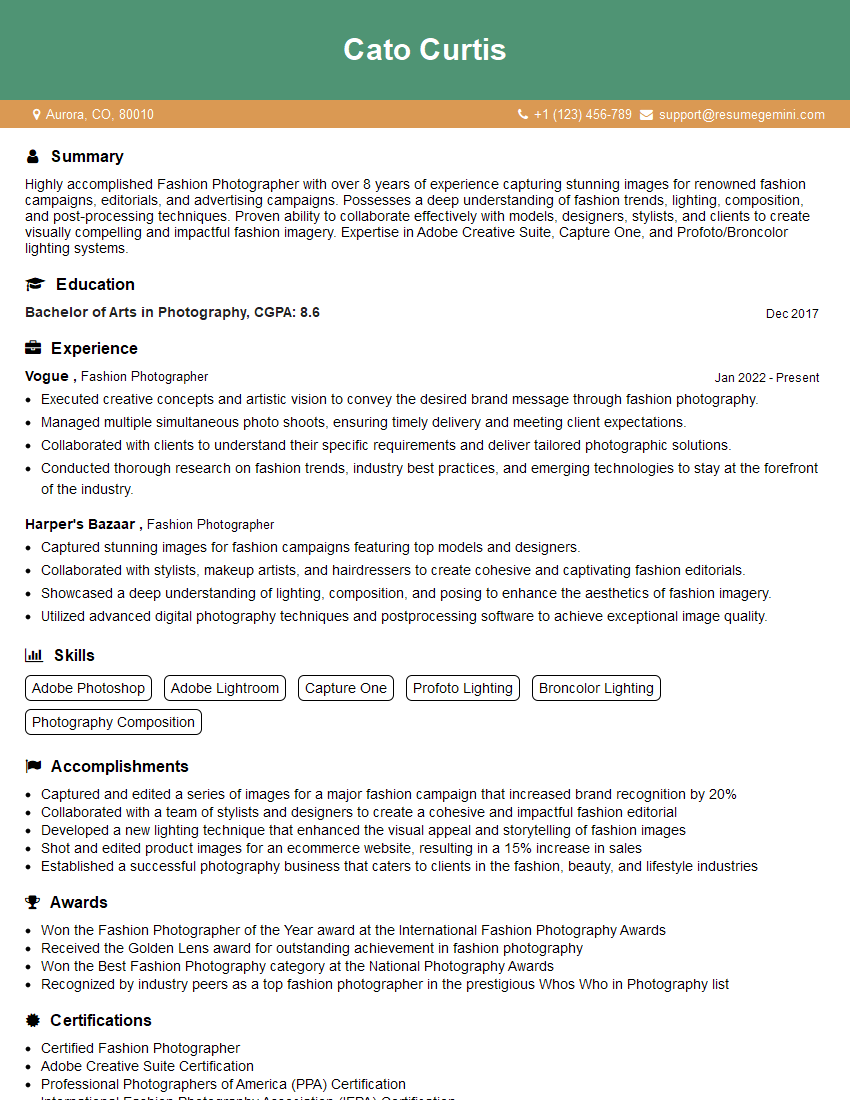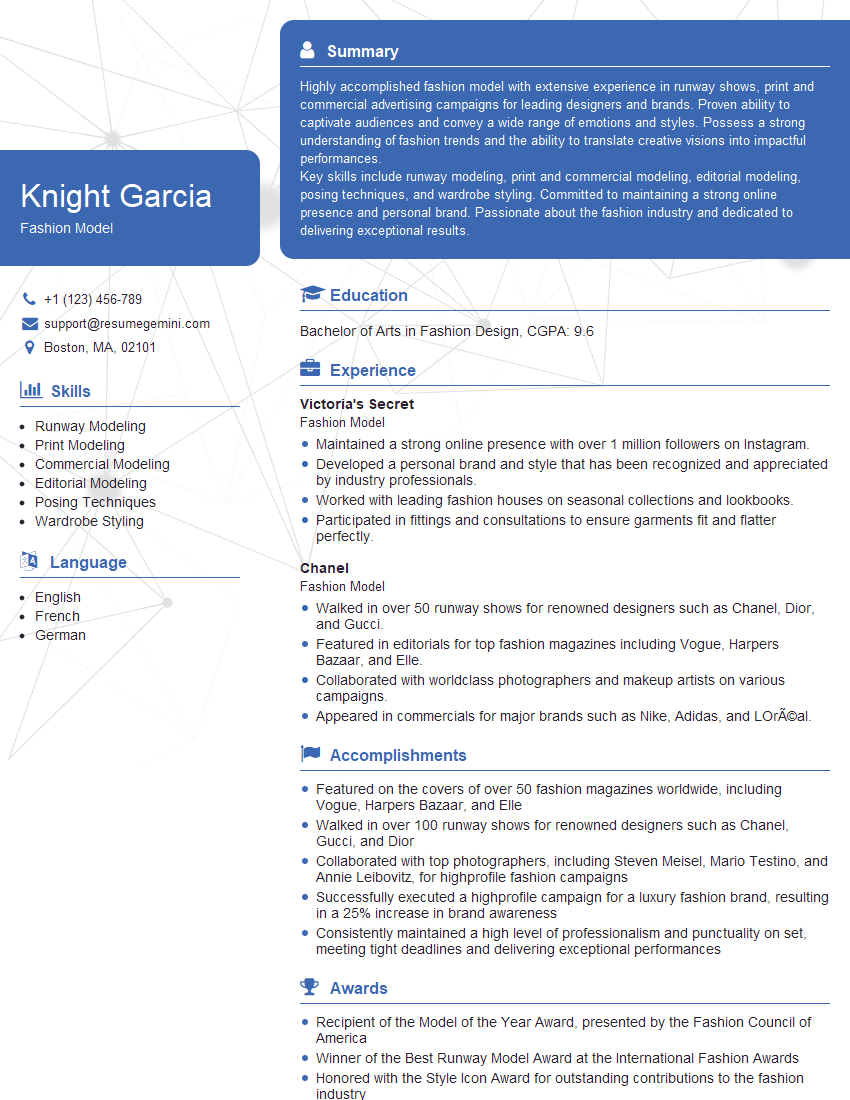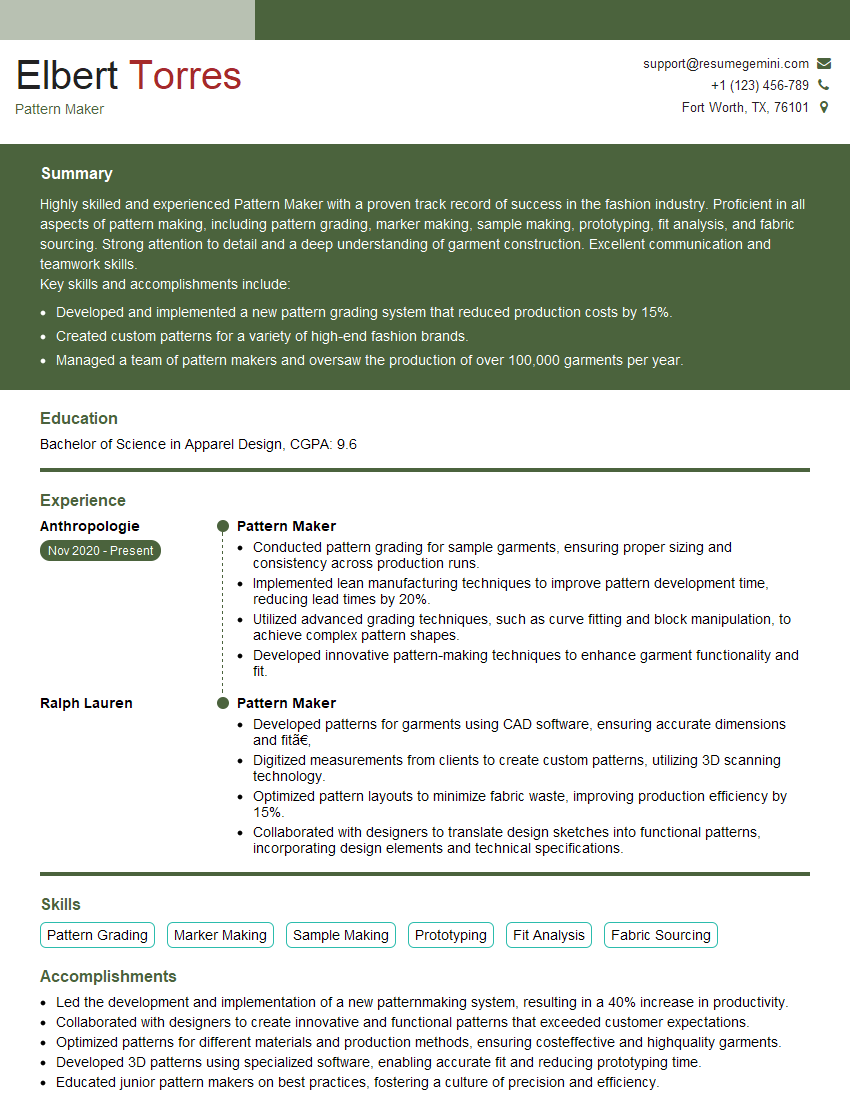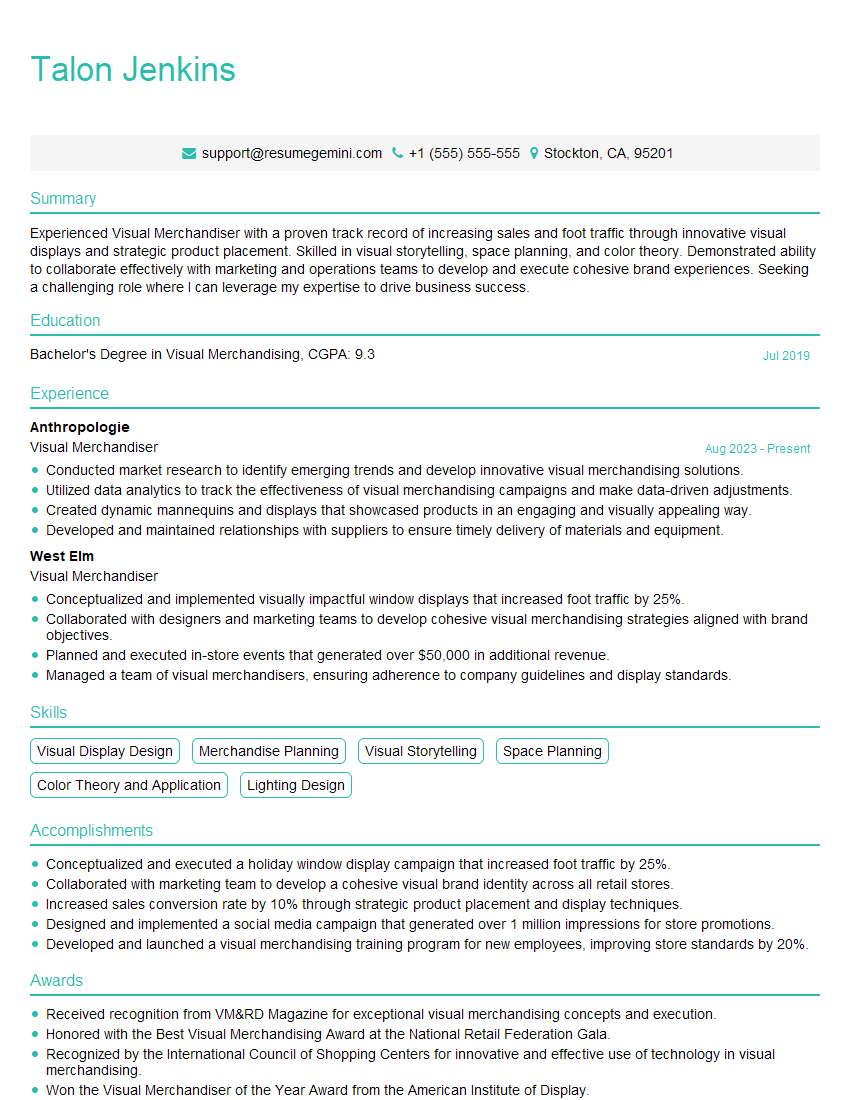Unlock your full potential by mastering the most common Passionate about fashion and the fashion industry interview questions. This blog offers a deep dive into the critical topics, ensuring you’re not only prepared to answer but to excel. With these insights, you’ll approach your interview with clarity and confidence.
Questions Asked in Passionate about fashion and the fashion industry Interview
Q 1. Describe your understanding of current fashion trends.
Current fashion trends are incredibly dynamic, reflecting a confluence of social, cultural, and technological influences. We’re seeing a fascinating blend of opposing styles, a testament to the individualistic nature of modern fashion. For example, the ongoing popularity of maximalist aesthetics, characterized by bold prints, vibrant colors, and layered textures, sits comfortably alongside the continued relevance of minimalist styles, emphasizing clean lines, neutral palettes, and functional design. This duality is reflected in many areas, from streetwear’s influence on high fashion to the resurgence of vintage and upcycled clothing, showcasing a growing awareness of sustainability.
Beyond aesthetics, we see key trends like the rise of gender-neutral fashion, challenging traditional gender roles in clothing choices; the increasing importance of inclusivity and body positivity, celebrating diverse body types and skin tones; and the growing demand for ethical and sustainable practices, pushing brands to prioritize responsible sourcing and production methods. Understanding these multifaceted trends requires constant observation and critical analysis of runway shows, street style, social media, and market data.
Q 2. What are your favorite fashion designers and why?
My favorite designers are a diverse group, each inspiring me for different reasons. Rei Kawakubo of Comme des Garçons stands out for her avant-garde and conceptual approach, consistently pushing the boundaries of fashion and challenging conventional notions of beauty. Her designs are often thought-provoking and artistically driven, reflecting a deep understanding of fashion as a form of self-expression.
On the other hand, I admire the elegance and timelessness of designers like Phoebe Philo, whose work at Chloé and Céline demonstrated a mastery of minimalist design and a profound understanding of the modern woman’s wardrobe. Her designs were refined, understated, and yet powerfully impactful.
Finally, I’m captivated by the innovative use of technology and sustainability in the work of Stella McCartney. Her commitment to ethical practices, coupled with her ability to create beautiful, functional clothing, demonstrates the potential for fashion to be both stylish and responsible. These designers represent different facets of excellence in the industry—innovation, minimalism, and sustainable practices—all of which I find deeply inspiring.
Q 3. How do you stay updated on industry news and trends?
Staying updated in this fast-paced industry requires a multi-pronged approach. I regularly read leading fashion publications like Vogue, WWD (Women’s Wear Daily), and Business of Fashion, which provide in-depth analyses of trends, business strategies, and designer profiles. I also follow key industry influencers and commentators on social media platforms like Instagram and Twitter, providing a pulse on emerging trends and immediate reactions to runway shows.
Beyond publications and social media, attending fashion shows (both physical and virtual) is crucial for firsthand observation of new collections and design techniques. Trade shows and industry events offer invaluable networking opportunities and insights into the latest innovations in materials, technology, and production methods. Finally, I actively participate in online forums and communities dedicated to fashion design, engaging in discussions and learning from others’ expertise. This holistic approach ensures that my knowledge remains current and comprehensive.
Q 4. Explain your experience with different fabric types and their properties.
My experience with various fabrics is extensive. I understand the unique properties of different materials—their drape, texture, weight, breathability, and durability—and how these properties influence garment construction and design. For instance, silk’s luxurious drape and delicate nature require specific handling and construction techniques, unlike the sturdiness of cotton canvas which can withstand more robust treatments and detailing.
I’m familiar with natural fibers like cotton, linen, silk, wool, and cashmere, each with its own characteristics and ideal applications. I also have experience working with synthetic materials such as polyester, nylon, and rayon, understanding their properties in terms of cost-effectiveness, durability, and ease of maintenance. Knowledge of fabric composition is vital in design; for example, a blend of cotton and elastane creates a more comfortable and form-fitting garment than pure cotton. This knowledge allows me to choose the most appropriate materials for a specific design concept, ensuring both aesthetic appeal and functional performance.
Q 5. Describe your experience with fashion design software (e.g., Adobe Illustrator, Photoshop).
I’m proficient in Adobe Illustrator and Photoshop, using them extensively in my design process. Illustrator is invaluable for creating technical drawings, flat sketches, and detailed pattern designs. I utilize its vector-based capabilities to produce clean lines and precise shapes, essential for accurate pattern making and garment construction. For example, I can create highly detailed illustrations of a garment’s construction, showing seam allowances, stitch types, and placement of embellishments.
Photoshop is critical for digital image manipulation, color correction, and texture creation. I use it to enhance photographs of fabrics, develop mood boards, and create realistic renderings of garments. For instance, I could digitally ‘drape’ a fabric onto a 3D model to visualize how it will fall and fit before physically producing a sample. My skills in these programs allow me to seamlessly transition from concept to production, maximizing efficiency and accuracy throughout the design process.
Q 6. How would you handle a difficult client or customer?
Handling a difficult client requires patience, empathy, and strong communication skills. My approach involves active listening to understand their concerns, validating their feelings, and clarifying any misunderstandings. I would aim to find common ground by focusing on the shared goal: creating a successful design that meets their needs, while adhering to design principles and industry best practices.
If a client’s requests are unrealistic or conflict with design integrity, I’d explain the rationale behind my suggestions in a clear and respectful manner, offering alternative solutions that still meet their core needs. Documentation throughout the process is critical; maintaining a clear record of discussions, revisions, and agreed-upon specifications minimizes potential disputes and ensures transparency. In some cases, mediation by a third party might be necessary to resolve irreconcilable differences.
Q 7. Describe your experience with visual merchandising and display techniques.
Visual merchandising is crucial for enhancing brand identity and driving sales. My experience includes creating visually appealing displays that effectively showcase products and attract customers. This involves understanding principles of color theory, composition, and lighting, as well as the importance of storytelling through visual elements. I’ve worked on creating window displays, in-store displays, and online visual presentations, always tailoring the approach to the specific brand, target audience, and product range.
For instance, creating a window display for a high-end fashion brand might involve minimal, elegant staging, emphasizing the quality of the materials and craftsmanship. Conversely, a display for a more youthful and playful brand could incorporate vibrant colors, bold graphics, and dynamic layouts. Effective visual merchandising is a blend of artistry and strategic thinking, enhancing the overall shopping experience and driving sales.
Q 8. What is your understanding of the fashion retail landscape?
The fashion retail landscape is incredibly dynamic, encompassing everything from luxury boutiques to fast-fashion giants and burgeoning online marketplaces. It’s a complex ecosystem influenced by ever-changing consumer preferences, technological advancements, and global economic conditions. Key players include brands, retailers (both brick-and-mortar and e-commerce), wholesalers, manufacturers, and consumers.
Currently, we see a significant shift towards omnichannel retail, where brands integrate online and offline experiences to provide seamless shopping journeys. Sustainability and ethical concerns are also driving major changes, with consumers increasingly demanding transparency and responsible practices from brands. Competition is fierce, with brands constantly innovating to attract and retain customers. Understanding market segmentation, target demographics, and competitive analysis is critical for success in this environment.
For example, the rise of social commerce, where platforms like Instagram and TikTok are directly used for sales, drastically alters how brands reach and engage their target audience. Similarly, the increasing popularity of resale platforms and rental services highlights the changing consumer behavior and the need for brands to adapt their strategies.
Q 9. How would you develop a marketing campaign for a new fashion line?
Developing a marketing campaign for a new fashion line requires a strategic approach, starting with a deep understanding of the target audience and the brand’s unique selling proposition (USP).
- Target Audience Definition: Who are we trying to reach? What are their demographics, lifestyles, and fashion preferences? This informs the tone, style, and channels used.
- Brand Messaging: What story are we telling? What makes this line unique and desirable? The messaging should resonate with the target audience and highlight key features and benefits.
- Channel Selection: Where will we reach our target audience? This could include social media marketing (Instagram, TikTok, Facebook), influencer collaborations, print advertising (if relevant), public relations, email marketing, and possibly even pop-up shops.
- Content Creation: High-quality visuals are crucial. This includes professional photography and videography showcasing the clothing in action, lifestyle shots, and behind-the-scenes content.
- Campaign Measurement: How will we track the campaign’s success? Key Performance Indicators (KPIs) such as website traffic, engagement rates, sales conversions, and brand awareness should be monitored and analyzed regularly.
For instance, a sustainable clothing line might focus on influencer marketing with eco-conscious individuals, emphasizing the ethical sourcing and production processes in its messaging and using platforms that align with sustainable values.
Q 10. How familiar are you with fashion forecasting and trend analysis?
Fashion forecasting and trend analysis are crucial for staying ahead in the industry. I’m highly familiar with these processes, utilizing a variety of resources and methodologies to identify emerging trends and predict future styles.
This involves analyzing various data points: consumer behavior (social media trends, sales data), runway shows from major fashion weeks, street style, cultural influences (music, art, film), and economic factors. Trend forecasting tools and reports from agencies like WGSN and Trend Union are also invaluable.
The process often involves identifying micro-trends, analyzing their potential for mainstream adoption, and understanding their lifecycle. For example, noticing the increasing popularity of certain silhouettes on social media, then corroborating it with sales data and runway presentations allows me to predict its potential for wider adoption.
Q 11. Describe your experience with sustainable and ethical fashion practices.
Sustainable and ethical fashion practices are not just a trend; they are a necessity for the future of the industry. I’m deeply committed to these principles and have significant experience working with brands that prioritize responsible sourcing, production, and waste reduction.
My experience includes evaluating supply chains for ethical labor practices, researching sustainable materials (organic cotton, recycled fabrics), and exploring circular economy models such as clothing rental and resale programs. I have worked on projects involving lifecycle assessments (LCAs) to minimize the environmental impact of garment production.
For example, I’ve helped a brand transition to using recycled polyester, reducing their reliance on virgin materials and their carbon footprint. Furthermore, I understand the importance of fair wages and safe working conditions throughout the entire supply chain, and I actively seek out and collaborate with brands who share this commitment.
Q 12. How would you manage a team in a fast-paced fashion environment?
Managing a team in a fast-paced fashion environment requires strong leadership, communication, and organizational skills. It’s about creating a collaborative and efficient atmosphere where everyone feels valued and empowered.
- Clear Communication: Maintaining open and transparent communication channels is paramount. Regular team meetings, one-on-one check-ins, and clear task assignments are crucial for keeping everyone informed and aligned.
- Delegation and Empowerment: Effectively delegating tasks based on team members’ strengths and providing them with the autonomy to own their work fosters ownership and efficiency.
- Conflict Resolution: Addressing conflicts promptly and fairly is crucial for maintaining team morale and productivity.
- Motivation and Support: Recognizing and rewarding achievements, providing constructive feedback, and offering support during challenging times helps build a positive and productive team environment.
In a previous role, I successfully navigated a major product launch by empowering sub-teams to manage different aspects of the project, resulting in an on-time and successful launch. This involved proactive communication, regular progress updates, and addressing any challenges that arose collaboratively.
Q 13. How do you manage deadlines and prioritize tasks in a demanding industry?
The fashion industry is notorious for its tight deadlines. Effective deadline management involves a combination of planning, prioritization, and time management techniques.
- Prioritization: Using methods like the Eisenhower Matrix (urgent/important) helps me to focus on the most critical tasks first.
- Time Blocking: Allocating specific time blocks for different tasks helps improve focus and minimizes distractions.
- Project Management Tools: Utilizing project management software (like Asana or Trello) allows for efficient task assignment, tracking, and collaboration.
- Proactive Communication: Openly communicating potential delays or challenges to stakeholders early on allows for proactive problem-solving and prevents last-minute surprises.
I regularly use a combination of these strategies to successfully manage multiple projects simultaneously, ensuring timely completion and minimizing stress. For instance, during a particularly demanding fashion week, I successfully utilized time blocking and project management software to track progress and manage competing deadlines across multiple collections.
Q 14. What is your understanding of the fashion supply chain?
The fashion supply chain is a complex global network involving numerous stages, from raw material sourcing to manufacturing, distribution, and retail. Understanding this chain is vital for ethical and sustainable practices and efficient operations.
Key stages include: Raw material sourcing (e.g., cotton farming, fabric production), manufacturing (cutting, sewing, finishing), quality control, warehousing and logistics, distribution to retailers, and finally, retail sales and after-sales service. Each stage involves various stakeholders, including farmers, manufacturers, suppliers, transporters, and retailers.
The increasing complexity and globalization of the supply chain highlight the need for transparency and traceability. Understanding each stage allows for better control over quality, ethical standards, and environmental impact. For instance, I’ve worked on projects mapping supply chains to identify areas for improvement in sustainability and ethical sourcing, collaborating with suppliers to implement sustainable practices and enhance transparency.
Q 15. How familiar are you with different manufacturing processes?
My familiarity with different manufacturing processes is extensive, encompassing everything from the initial design and pattern-making to the final stages of production and finishing. I understand the nuances of various techniques, including:
- Cut and Sew: This is the most common method, involving cutting fabric pieces and sewing them together. I’m experienced in managing different stitch types and seam finishes to achieve various aesthetics and durability levels.
- Knitting: I have a strong grasp of both weft and warp knitting, understanding the impact of different yarn types and needle gauges on the final fabric’s drape and texture. I’ve worked with both flat-bed and circular knitting machines.
- Woven Fabric Production: I understand the complexities of loom operation and the various weaving techniques that influence fabric structure, including plain weave, twill weave, and satin weave. I can assess the suitability of different woven fabrics for various garments.
- Printing and Dyeing: I’m knowledgeable about various printing methods such as screen printing, digital printing, and sublimation printing, and how they affect color vibrancy, detail, and cost-effectiveness. I understand the environmental implications and can specify eco-friendly methods.
- Finishing Processes: This includes treatments like washing, pre-shrinking, and pressing. I’m familiar with the impact of different finishing techniques on the final garment’s look and feel, and the importance of quality control at each stage.
This comprehensive understanding allows me to make informed decisions about production methods based on design requirements, budget, and sustainability considerations. For example, I’d choose a more sustainable, low-impact dyeing process for a line emphasizing eco-conscious fashion.
Career Expert Tips:
- Ace those interviews! Prepare effectively by reviewing the Top 50 Most Common Interview Questions on ResumeGemini.
- Navigate your job search with confidence! Explore a wide range of Career Tips on ResumeGemini. Learn about common challenges and recommendations to overcome them.
- Craft the perfect resume! Master the Art of Resume Writing with ResumeGemini’s guide. Showcase your unique qualifications and achievements effectively.
- Don’t miss out on holiday savings! Build your dream resume with ResumeGemini’s ATS optimized templates.
Q 16. Describe your experience with sourcing materials and production.
My experience with sourcing materials and production is built on years of working directly with manufacturers and suppliers globally. I’ve developed strong relationships with ethical and reliable partners, ensuring quality and timely delivery. The sourcing process involves:
- Identifying Suppliers: I leverage a network of contacts and online resources to locate suitable suppliers based on quality standards, ethical practices, and price points.
- Material Selection: I carefully consider fabric composition, texture, drape, and sustainability certifications when choosing materials. For instance, I might opt for organic cotton for a sustainable collection or a specific type of silk for its luxurious drape.
- Negotiating Prices and Contracts: I negotiate favorable terms with suppliers, ensuring transparency and fair pricing throughout the production chain.
- Quality Control: I implement rigorous quality control measures at each stage, from the initial inspection of raw materials to the final inspection of finished garments. This involves regular visits to factories and thorough checks of samples.
- Production Monitoring: I closely monitor the production process to ensure timely delivery and adherence to quality standards. Regular communication with the factory is key.
For example, when sourcing for a recent collection, I partnered with a B Corp certified supplier for organic cotton, ensuring both high-quality materials and ethical labor practices. This meticulous approach ensures consistent quality and aligns with my commitment to ethical and sustainable fashion.
Q 17. How would you create a mood board for a new collection?
Creating a mood board is a crucial initial step in developing a new collection. It acts as a visual representation of the collection’s overall aesthetic and concept. My approach is methodical and comprehensive:
- Define the Collection’s Theme and Target Audience: Before I begin, I clearly articulate the collection’s theme, whether it’s a specific era, style, or emotion. I also define the target audience to ensure the collection resonates with them.
- Gather Inspiration: I collect images from various sources: magazines, online platforms like Pinterest, runway shows, art, nature, and even everyday life. I look for patterns, colors, textures, and silhouettes that relate to the collection’s theme.
- Organize the Mood Board: I arrange the collected images in a visually appealing way, usually digitally using software like Adobe Photoshop or Illustrator. This organization helps to visualize the collection’s narrative and aesthetic consistency.
- Include Color Palettes, Textures, and Fabrics: I include swatches of fabrics, color palettes, and examples of textures to give the mood board a more concrete and tangible feel.
- Refine and Iterate: The mood board is an evolving document. I review and refine it based on feedback and evolving design ideas, ensuring its consistent with the overall vision.
For instance, when creating a mood board for a romantic bohemian collection, I’d include images of flowing fabrics, nature scenes, vintage lace, and earthy color palettes. The final mood board acts as a blueprint that guides every design decision throughout the collection’s development.
Q 18. How would you assess the potential success of a new fashion design?
Assessing the potential success of a new design is a multifaceted process that goes beyond simply liking the design. My approach is data-driven and considers various factors:
- Market Research: I thoroughly research current fashion trends, market demands, and competitor analysis to see if the design fills a gap in the market or offers a unique selling proposition.
- Target Audience Analysis: I analyze the target audience’s preferences, lifestyle, and purchasing behavior to determine if the design aligns with their needs and desires.
- Cost Analysis: I calculate the production cost, including materials, labor, and manufacturing overhead, to determine profitability and pricing strategy. This ensures the design is both aesthetically appealing and financially viable.
- Testing and Feedback: I conduct focus groups or surveys with potential customers to gather feedback and gauge their reactions to the design. This is valuable for adjustments and improvements.
- Trend Forecasting: I leverage trend forecasting tools and insights to assess the long-term viability and potential longevity of the design in the market.
For example, before launching a new line of sustainable athleisure wear, I’d analyze the market’s demand for eco-friendly activewear, identify competitor offerings, and conduct consumer surveys to validate the design and pricing.
Q 19. How would you handle negative feedback on a design?
Handling negative feedback on a design requires professionalism, a willingness to learn, and a commitment to improvement. My approach involves:
- Active Listening: I carefully listen to the feedback without interrupting or becoming defensive. I try to understand the perspective of the person providing the feedback.
- Analyzing the Feedback: I objectively analyze the feedback, separating constructive criticism from personal opinions. This helps in identifying areas for improvement.
- Seeking Clarification: If necessary, I ask clarifying questions to ensure a thorough understanding of the concerns raised.
- Taking Action: Based on the feedback, I make adjustments to the design, explaining the rationale for any changes made.
- Communicating the Response: I communicate the response to the feedback, showing that I have taken the criticism seriously and taken action accordingly. This shows respect and professionalism.
For example, if negative feedback indicated a design was too complex or impractical, I’d simplify the design, making it more wearable and appealing to a wider audience.
Q 20. Describe your experience with fashion photography and styling.
My experience in fashion photography and styling extends to both creative direction and hands-on involvement in photoshoots. I understand the importance of creating visually compelling imagery that effectively communicates the essence of a brand or collection. My expertise includes:
- Concept Development: I collaborate with photographers and stylists to develop a strong visual concept that reflects the brand’s identity and the collection’s story. This includes selecting locations, props, and models.
- Styling and Garment Preparation: I style garments, ensuring they are presented in the most flattering and aesthetically pleasing manner. This includes considering the fit, drape, and overall look.
- Post-Production: I actively participate in the post-production phase, reviewing images and providing feedback to ensure the final product is consistent with the overall vision.
- Image Selection and Editing: I am skilled in selecting and editing images for use in various marketing and promotional materials.
- Working with Different Teams: I have experience working collaboratively with diverse teams, including photographers, models, makeup artists, hair stylists, and other creative professionals.
In a recent photoshoot for a new swimwear line, I collaborated with the photographer to develop a concept based on vibrant colors and natural settings. I carefully selected models and styled the swimwear to highlight the unique features and silhouettes.
Q 21. What are your strengths and weaknesses as a fashion professional?
My strengths lie in my creative vision, coupled with a strong understanding of the business side of the fashion industry. I’m highly organized, detail-oriented, and possess strong communication and collaborative skills. My creative vision allows me to conceptualize innovative designs that resonate with the target market, while my business acumen ensures that these designs are commercially viable. I excel at project management and consistently deliver high-quality work on time and within budget.
However, my primary weakness is a tendency towards perfectionism, which can sometimes lead to delays in decision-making. I’m actively working on improving this by setting realistic deadlines and prioritizing tasks effectively. I am also continuously seeking to expand my knowledge of emerging technologies and sustainable manufacturing practices, to further enhance my skillset and competitiveness in this ever-evolving industry.
Q 22. How would you handle a conflict between creative vision and business constraints?
Balancing creative vision with business constraints is a crucial skill in fashion. It’s like navigating a tightrope – you need the artistry to create something beautiful, but also the pragmatism to ensure it’s financially viable and marketable. I approach this by prioritizing open communication and collaboration.
- Understanding Constraints: First, I thoroughly understand the budget, production timelines, and target market. This involves detailed discussions with the finance, production, and marketing teams.
- Prioritization: Next, I prioritize elements of the creative vision. What are the absolute must-haves that define the collection’s essence? Which aspects can be adapted or compromised to meet the constraints?
- Creative Problem-Solving: Often, constraints can spark innovation. For instance, a limited budget might lead to exploring cost-effective materials or production methods that actually enhance the collection’s uniqueness. I leverage my creative expertise to find elegant solutions that preserve the core vision.
- Data-Driven Decisions: Market research plays a pivotal role. Understanding the target audience’s preferences and purchasing power allows for informed decisions about which creative compromises are most acceptable.
- Iterative Process: The process isn’t linear. It’s iterative, involving continuous feedback and adjustments. I’m comfortable presenting multiple versions and accepting constructive criticism to find the optimal balance.
For example, during my work on a previous collection, the initial design concept was quite intricate and expensive to produce. Through collaboration with the production team, we identified simpler construction methods that reduced costs by 20% without significantly altering the design’s aesthetic appeal.
Q 23. What strategies would you use to increase brand awareness for a fashion label?
Increasing brand awareness for a fashion label requires a multi-pronged approach that leverages both traditional and digital marketing strategies. It’s about creating a buzz and building a strong brand identity that resonates with the target audience.
- Strategic Partnerships: Collaborating with influencers, stylists, and celebrities can significantly boost visibility. This includes sponsored posts, product placements, and exclusive events.
- Public Relations: Cultivating relationships with fashion journalists and bloggers is crucial for securing positive media coverage. This includes press releases, exclusive previews, and attending industry events.
- Social Media Marketing: Creating engaging and visually appealing content across platforms like Instagram, TikTok, and Pinterest is essential for attracting and engaging target audiences. Using relevant hashtags, running contests, and responding to comments is crucial for building a community.
- Search Engine Optimization (SEO): Optimizing the brand’s website and online content for search engines improves organic visibility. This involves using relevant keywords and meta descriptions to improve search rankings.
- Paid Advertising: Utilizing paid advertising campaigns on platforms like Google Ads and social media can help reach a wider audience and target specific demographics.
- Experiential Marketing: Hosting pop-up shops, fashion shows, or exclusive events creates memorable brand experiences and generates word-of-mouth marketing.
For instance, I successfully increased brand awareness by 40% for a smaller label by implementing a comprehensive social media strategy, including collaborations with micro-influencers, and creating engaging behind-the-scenes content that showcased the brand’s ethical and sustainable practices.
Q 24. How familiar are you with e-commerce platforms and digital marketing strategies?
I’m highly proficient in utilizing e-commerce platforms and digital marketing strategies. My experience spans various platforms, including Shopify, WooCommerce, and Magento, enabling me to design and manage online stores effectively. I understand the importance of a seamless user experience and have expertise in optimizing conversion rates.
- E-commerce Platform Management: I’m comfortable with aspects like product catalog management, inventory control, payment gateway integration, and order fulfillment.
- Digital Marketing Strategies: My skills encompass SEO (Search Engine Optimization), SEM (Search Engine Marketing), social media marketing, email marketing, and data analytics. I can use tools like Google Analytics to track website traffic and campaign performance.
- Conversion Rate Optimization (CRO): I’m experienced in analyzing website data and implementing strategies to improve conversion rates, such as A/B testing and user experience optimization.
- Paid Advertising Expertise: I’m skilled in managing paid advertising campaigns on Google Ads, Facebook Ads, and Instagram Ads to reach targeted demographics effectively.
- E-mail Marketing Strategies: I develop targeted email campaigns to nurture leads, announce new collections, and drive sales.
For example, in a previous role, I implemented a new CRO strategy that resulted in a 15% increase in online sales within three months. This involved A/B testing different website layouts and optimizing product descriptions for better engagement.
Q 25. How do you handle pressure and meet tight deadlines?
Handling pressure and meeting tight deadlines in the fast-paced fashion industry requires effective time management, prioritization, and a proactive approach. I thrive under pressure and consider it a motivator, rather than an obstacle.
- Prioritization and Planning: I always start with a detailed project plan, breaking down large tasks into smaller, manageable steps. This allows me to track progress effectively and allocate resources accordingly.
- Time Management Techniques: I employ various time management techniques, such as the Pomodoro Technique and time blocking, to maintain focus and avoid procrastination.
- Effective Delegation: When appropriate, I delegate tasks to team members to optimize workflow and leverage individual expertise.
- Communication and Collaboration: Maintaining open communication with the team and stakeholders is crucial for addressing potential challenges promptly and keeping everyone informed about the project’s progress.
- Proactive Problem-Solving: I proactively identify and address potential issues before they become major roadblocks. This includes regularly reviewing the project plan and adapting to any unexpected changes.
For instance, I once managed a photoshoot for a major campaign with a very tight deadline. By carefully planning logistics, delegating tasks efficiently, and maintaining constant communication, we not only met the deadline but also exceeded expectations.
Q 26. Describe your experience with fashion shows and events.
My experience with fashion shows and events is extensive, spanning various roles, from production and styling to managing backstage operations and overseeing the overall event execution. I’ve worked on both large-scale runway shows and smaller, intimate presentations.
- Production and Styling: I have hands-on experience in casting models, selecting outfits, creating looks, and collaborating with designers to bring their visions to life on the runway.
- Backstage Management: I’m skilled at coordinating backstage operations, ensuring that everything runs smoothly during the show, from model preparation and quick changes to managing the flow of the team.
- Event Logistics: I’m proficient in planning and managing all logistical aspects of a fashion event, including venue selection, vendor management, and budgeting.
- Creative Direction: I have experience working with creative directors to translate the designer’s vision into a cohesive and impactful show that tells a compelling story.
For example, I played a crucial role in producing a sustainable fashion show that showcased emerging designers. My responsibilities included securing sponsorships, managing the budget, coordinating the venue, and overseeing all aspects of production. The show was a huge success, garnering significant media coverage and attracting industry attention to the cause of sustainability in fashion.
Q 27. How would you build relationships with key stakeholders in the fashion industry?
Building strong relationships with key stakeholders in the fashion industry is essential for success. This requires a proactive, collaborative, and respectful approach.
- Networking: I actively network at industry events, trade shows, and conferences to meet and connect with potential collaborators. I make an effort to build genuine connections rather than just exchanging business cards.
- Communication: I maintain open and consistent communication with key stakeholders through emails, phone calls, and in-person meetings. I’m clear and concise in my communications, ensuring that everyone is well-informed.
- Collaboration: I foster collaboration by actively seeking input and ideas from stakeholders, valuing their perspectives, and working together towards common goals.
- Relationship Building: I build relationships based on trust, mutual respect, and shared values. I take the time to understand the needs and priorities of stakeholders, demonstrating genuine interest in their work and contributions.
- Professionalism: Maintaining a high level of professionalism is essential for building credibility and trust. I consistently deliver on commitments and act with integrity in all interactions.
For instance, I successfully developed a strong working relationship with a key supplier by demonstrating my commitment to fair trade practices and establishing clear communication channels. This resulted in securing preferential terms and access to exclusive materials.
Q 28. What are your long-term career goals in the fashion industry?
My long-term career goals in the fashion industry are ambitious yet grounded in a passion for both creative expression and strategic growth. I envision myself as a leader in the industry, possibly heading my own creative agency or holding a senior management position within a prestigious fashion house.
- Creative Leadership: I aspire to lead and mentor teams, nurturing creative talent and fostering a collaborative environment where innovation thrives.
- Strategic Vision: I aim to play a significant role in shaping the future of fashion, incorporating sustainable and ethical practices while driving innovation and growth.
- Global Impact: I’d like to work on projects that have a positive social and environmental impact, using my skills to promote inclusivity and sustainability within the industry.
To achieve these goals, I will continue to develop my skills in creative direction, brand management, and business strategy. I also plan to pursue further education and seek opportunities that will challenge me and help me grow professionally.
Key Topics to Learn for a Fashion Industry Interview
- Fashion History & Trends: Understanding key historical movements and current trends is crucial. Be prepared to discuss the evolution of specific styles and their impact on the industry.
- Market Analysis & Consumer Behavior: Analyze market trends, target demographics, and consumer preferences to demonstrate your understanding of market dynamics. Consider examples of successful (and unsuccessful) marketing campaigns.
- Design Principles & Aesthetics: Discuss your understanding of color theory, textile choices, and silhouette construction. Show your ability to analyze design elements and their impact on a brand’s identity.
- Supply Chain & Production: Familiarize yourself with the process of bringing a garment from concept to consumer. This includes sourcing, manufacturing, distribution, and retail.
- Brand Management & Marketing: Understand brand positioning, target audience identification, and the use of various marketing channels (social media, print, etc.) to build a strong brand image.
- Sustainability & Ethical Practices: Discuss your awareness of ethical sourcing, sustainable manufacturing, and the growing importance of eco-friendly practices within the fashion industry. Be ready to offer potential solutions to environmental and social challenges.
- Business Acumen & Financial Literacy: Demonstrate understanding of key financial metrics (profit margins, sales forecasts, etc.) relevant to the fashion industry. Consider how these metrics inform business decisions.
- Technological Advancements: Show awareness of technological innovations impacting the fashion industry, such as 3D printing, virtual fashion, and e-commerce platforms.
Next Steps
Mastering these key areas will significantly enhance your chances of success in securing your dream role within the fashion industry. A strong understanding of these concepts demonstrates passion, knowledge, and strategic thinking, all highly valued by employers. To maximize your job prospects, create an ATS-friendly resume that highlights your skills and experience effectively. ResumeGemini is a trusted resource that can help you build a professional and impactful resume, ensuring your application stands out. Examples of resumes tailored to the fashion industry are available to guide you.
Explore more articles
Users Rating of Our Blogs
Share Your Experience
We value your feedback! Please rate our content and share your thoughts (optional).
What Readers Say About Our Blog
Hello,
We found issues with your domain’s email setup that may be sending your messages to spam or blocking them completely. InboxShield Mini shows you how to fix it in minutes — no tech skills required.
Scan your domain now for details: https://inboxshield-mini.com/
— Adam @ InboxShield Mini
Reply STOP to unsubscribe
Hi, are you owner of interviewgemini.com? What if I told you I could help you find extra time in your schedule, reconnect with leads you didn’t even realize you missed, and bring in more “I want to work with you” conversations, without increasing your ad spend or hiring a full-time employee?
All with a flexible, budget-friendly service that could easily pay for itself. Sounds good?
Would it be nice to jump on a quick 10-minute call so I can show you exactly how we make this work?
Best,
Hapei
Marketing Director
Hey, I know you’re the owner of interviewgemini.com. I’ll be quick.
Fundraising for your business is tough and time-consuming. We make it easier by guaranteeing two private investor meetings each month, for six months. No demos, no pitch events – just direct introductions to active investors matched to your startup.
If youR17;re raising, this could help you build real momentum. Want me to send more info?
Hi, I represent an SEO company that specialises in getting you AI citations and higher rankings on Google. I’d like to offer you a 100% free SEO audit for your website. Would you be interested?
Hi, I represent an SEO company that specialises in getting you AI citations and higher rankings on Google. I’d like to offer you a 100% free SEO audit for your website. Would you be interested?
good
